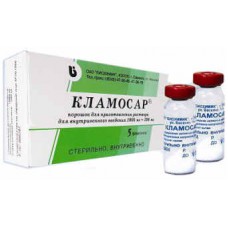Expiration date: 07/2026
Composition and form of issue:
Powder for preparation of injection solution for intravenous infusion 1 FL.
amoxicillin 0, 5 g
potassium clavulanate 0, 1 g
in bottles in the stack cartons 1 or 5 bottles or in cardboard box of 50 bottles.
Powder for preparation of injection solution for intravenous infusion 1 FL.
amoxicillin (in the form of sodium salt) 1 g
potassium clavulanate 0, 2 g,
in bottles in the stack cartons 1 or 5 bottles or in cardboard box of 50 bottles.
Description of dosage form:
White or white with a yellowish tinge of color, crystalline, hygroscopic powder.
Characteristic:
Semi-synthetic penicillin combined with beta-lactamase inhibitor.
Pharmacological action:
The combination of amoxicillin - a bactericidal penicillin antibiotic with a broad spectrum of action, and clavulanic acid-an irreversible inhibitor of beta-lactamase, which forms stable and inactive complexes with enzymes that destroy amoxicillin. Clavulanic acid protects amoxicillin from decomposition and, consequently, from the loss of antibacterial action on numerous gram-negative microorganisms that form beta-lactamases.
Pharmacokinetics:
The pharmacokinetics of amoxicillin and clavulanic acid are similar. After the on/in the introduction in doses of 1200 mg and 600 mg C Max amoxicillin — 105, 4 µg/ml and 32, 2 µg/ml, respectively, clavulanic acid is — 28, 5 µg/ml and 10, 5 µg/ml, respectively. Plasma protein binding: amoxicillin-17-20%, clavulanic acid — 23-30%. Metabolized both components in the liver: amoxicillin-10% of the dose, clavulanic acid — 50%. T1/2 after I / in the dose of 1, 2 g and 600 mg — 0, 9 and 1, 07 h for amoxicillin, 0, 9 and 1, 12 h — for clavulanic acid, respectively. Write mainly kidneys (glomerular filtration and tubular secretion): 50-78% and 25-40% of a dose of amoxicillin and clavulanic acid, respectively, is excreted unchanged during the first 6 h after injection.
Description of the pharmacological action:
Bactericidal against a wide range of gram-positive and gram-negative microorganisms, aerobic and anaerobic pathogens (including those strains that have formed resistance to beta-lactam antibiotics due to the production of beta-lactamases).
Active against aerobic gram-positive bacteria (including strains, producing beta-lactamases): Staphylococcus aureus, Staphylococcus epidermidis, Streptococcus pyogenes, Streptococcus anthracis, Streptococcus pneumoniae, Streptococcus viridans, Enterococcus faecalis, Corynebacterium spp., Listeria monocytogenes of anaerobic gram-positive bacteria: Clostridium spp., Peptococcus spp., Peptostreptococcus spp aerobic gram-negative bacteria (including strains producing beta-lactamases): Escherichia coli, Proteus mirabilis, Proteus vulgaris, Klebsiella spp., Salmonella spp., Shigella spp., Bordetella pertussis, Yersinia enterocolitica, Gardnerella vaginalis, Neisseria meningitidis, Neisseria gonorrhoeae, Moraxella catarrhalis, Haemophilus influenzae , Haemophilus ducreyi, Yersinia multocida (formerly Pasteurella), Campylobacter jejuni anaerobic bacteria (including gram-positive strains) producing beta-lactamases): Bacteroides spp., including Bacteroides fragilis.
Clavulanic acid suppresses II, III, IV and V types of beta-lactamases, is inactive against type I beta-lactamases produced by Enterobacter spp., Pseudomonas aeruginosa, Serratia spp., Acinetobacter spp. Clavulanic acid has a high tropism to penicillinases and forms a stable complex with the enzyme, which prevents the enzymatic degradation of amoxicillin under the influence of beta-lactamases.
Indications:
Respiratory tract infections (acute and chronic bronchitis, lobar and bronchopneumonia, empyema, lung abscess, infections of the ear, nose and throat) infections of the genitourinary system and the pelvic organs (pyelonephritis, pyelitis, cystitis, urethritis, prostatitis, cervicitis, salpingitis, oophoritis, tubo-ovarian abscess, endometritis, bacterial vaginitis, septic abortion, puerperal sepsis, pelvioperitonit, chancroid, gonorrhea) infections of skin and soft tissues (abscesses, inflammation of soft tissue, erysipelas, impetigo, secondarily infected dermatoses, abscess, phlegmon, wound infection) infections of the biliary tract (cholangitis, cholecystitis), intestinal infections (dysentery, salmonellosis, salmonellosis) abdominal sepsis, other infections — osteomyelitis, endocarditis, meningitis, septicaemia, peritonitis, infections after surgery.
It is also used for the prevention of infections associated with major surgical operations on the gastrointestinal tract, in the pelvis, head and neck, heart, kidneys, bile ducts.
Contraindications:
Hypersensitivity to penicillin antibiotics, infectious mononucleosis, lymphocytic leukemia.
Application for pregnancy and breastfeeding:
Acceptably. No teratogenic effect was found in experimental animal studies.
Side effect:
Dyspeptic phenomena (nausea, vomiting, diarrhea), allergic reactions (erythema, rash).
Drug interaction:
Farmatsevticeski incompatible with solutions containing blood, proteins, lipids, glucose, dextran bicarbonate concomitant use with allopurinol increases the risk of exanthema to avoid co-administration with disulfiram.
Method of application and doses:
Administered slowly, over 3-4 minutes, not later than 20 min after dissolution. For infusion 600 mg of substance is dissolved in 50 ml of solution for infusion or 1, 2 g of substance in 100 ml solution. The duration of drip infusion-30-40 min. the Drug can be administered in various infusion solutions, except for glucose (dextrose).
Adults and children over 12 years: 1, 2 g every 8 h, with more severe infections, the interval between injections is reduced to 6 h.
Children from 3 months to 12 years: 30 mg / kg every 8 hours, with more severe infections, the interval between injections is reduced to 6 hours.
Children under 3 months: 30 mg / kg every 12 h in premature infants and infants, then the interval between injections is reduced to 8 hours.
30 mg injected intravenously of the drug contains 25mg of amoxicillin and 5mg clavulanic acid.
In surgical practice, Clamour used to protect against infection during surgery. Adults are administered in / in 1, 2 g before anesthesia, if the intervention lasts more than an hour. The course of treatment can be extended for a few days, if the intervention has increased the risk of infection. The drug should be used and in postoperative treatment.
With a decrease in renal function: adults with mild insufficiency (creatinine Cl > 30 ml / min) there is no need to reduce the dosage with moderate insufficiency (creatinine Cl-10-30 ml / min) begin treatment with the introduction of 1, 2 g/in, then 600 mg / in every 12 hours with severe renal insufficiency (creatinine Cl < 10 ml / min) begin treatment with the introduction of 1, 2 g / in, then continue to 600 mg / in every 24 therefore, the drug is prescribed at a dose of 600 mg/in during or after dialysis. Dosage for children is also reduced.
Treatment for adults and children can last for 14 days, after which it is necessary to decide whether to continue or cancel antibacterial therapy.
Overdose:
Symptoms: nausea, diarrhea, vomiting.
Treatment: symptomatic effective hemodialysis.
Special instruction:
The finished solution for injection use within 20 minutes after cooking.
Storage conditions:
The finished solution for injection do not freeze.


